Monkeypox Outbreak in Peru
Abstract
1. Introduction
2. COVID-19 Pandemic in Peru
3. Epidemiology
4. Transmission and Population at Risk
5. Sexually Transmitted Infections Concomitant
6. MPXV Outbreak in Peru
7. Mpox Outbreak and Global Health Security Index
8. MPXV Vaccination
9. Reflections and Recommendations
Funding
Institutional Review Board Statement
Informed Consent Statement
Data Availability Statement
Conflicts of Interest
References
- McCollum, A.M.; Damon, I.K. Human monkeypox. Clin. Infect. Dis. 2014, 58, 260–267, Erratum in Clin. Infect. Dis. 2014, 58, 1792. [Google Scholar] [CrossRef] [PubMed]
- Lum, F.M.; Torres-Ruesta, A.; Tay, M.Z.; Lin, R.T.P.; Lye, D.C.; Rénia, L.; Ng, L.F.P. Monkeypox: Disease epidemiology, host immunity and clinical interventions. Nat. Rev. Immunol. 2022, 22, 597–613. [Google Scholar] [CrossRef] [PubMed]
- Bunge, E.M.; Hoet, B.; Chen, L.; Lienert, F.; Weidenthaler, H.; Baer, L.R.; Steffen, R. The changing epidemiology of human monkeypox-A potential threat? A systematic review. PLoS Negl. Trop. Dis. 2022, 16, e0010141. [Google Scholar] [CrossRef] [PubMed]
- Ejaz, H.; Junaid, K.; Younas, S.; Abdalla, A.E.; Bukhari, S.N.A.; Abosalif, K.O.A.; Ahmad, N.; Ahmed, Z.; Hamza, M.A.; Anwar, N. Emergence and dissemination of monkeypox, an intimidating global public health problem. J. Infect. Public Health 2022, 15, 1156–1165. [Google Scholar] [CrossRef]
- Velavan, T.P.; Meyer, C.G. Monkeypox 2022 outbreak: An update. Trop. Med. Int. Health 2022, 27, 604–605. [Google Scholar] [CrossRef]
- Damaso, C.R. The 2022 monkeypox outbreak alert: Who is carrying the burden of emerging infectious disease outbreaks? Lancet Reg. Health Am. 2022, 13, 100315. [Google Scholar] [CrossRef]
- Thornhill, J.P.; Barkati, S.; Walmsley, S.; Rockstroh, J.; Antinori, A.; Harrison, L.B.; Palich, R.; Nori, A.; Reeves, I.; Habibi, M.S.; et al. Monkeypox Virus Infection in Humans across 16 Countries—April-June 2022. N. Engl. J. Med. 2022, 387, 679–691. [Google Scholar] [CrossRef]
- Mitjà, O.; Alemany, A.; Marks, M.; Mora, J.I.L.; Rodríguez-Aldama, J.C.; Silva, M.S.T.; Herrera, E.A.C.; Crabtree-Ramirez, B.; Blanco, J.L.; Girometti, N.; et al. Mpox in people with advanced HIV infection: A global case series. Lancet 2023, 401, 939–949. [Google Scholar] [CrossRef]
- World Health Organization. WHO Coronavirus (COVID-19) Dashboard. Peru. WHO: Geneva. 2022. Available online: https://covid19.who.int/region/amro/country/pe (accessed on 25 April 2023).
- COVID-19 Excess Mortality Collaborators. Estimating excess mortality due to the COVID-19 pandemic: A systematic analysis of COVID-19-related mortality, 2020–2021. Lancet 2022, 399, 1513–1536. [Google Scholar] [CrossRef]
- Ramírez-Soto, M.C.; Ortega-Cáceres, G.; Arroyo-Hernández, H. Excess all-cause deaths stratified by sex and age in Peru: A time series analysis during the COVID-19 pandemic. BMJ Open 2022, 12, e057056. [Google Scholar] [CrossRef]
- Herrera-Añazco, P.; Uyen-Cateriano, A.; Mezones-Holguin, E.; Taype-Rondan, A.; Mayta-Tristan, P.; Malaga, G.; Hernandez, A.V. Some lessons that Peru did not learn before the second wave of COVID-19. Int. J. Health Plan. Manag. 2021, 36, 995–998. [Google Scholar] [CrossRef] [PubMed]
- Schwalb, A.; Seas, C. The COVID-19 Pandemic in Peru: What Went Wrong? Am. J. Trop. Med. Hyg. 2021, 104, 1176–1178. [Google Scholar] [CrossRef] [PubMed]
- Ministry of Health, Peru (MINSA). Situation of COVID-19 Peru. Lima: MINSA. 2022. Available online: https://covid19.minsa.gob.pe/sala_situacional.asp (accessed on 25 April 2023).
- US Centers for Disease Control and Prevention. Human monkeypox—Kasai Oriental, Democratic Republic of Congo, February 1996–October 1997. Morb. Mortal. Wkly. Rep. 1997, 46, 1168–1171. [Google Scholar]
- Heymann, D.L.; Szczeniowski, M.; Esteves, K. Re-emergence of monkeypox in Africa: A review of the past six years. Br. Med. Bull. 1998, 54, 693–702. [Google Scholar] [CrossRef]
- Jezek, Z.; Szczeniowski, M.; Paluku, K.M.; Mutombo, M. Human monkeypox: Clinical features of 282 patients. J. Infect. Dis. 1987, 156, 293–298. [Google Scholar] [CrossRef] [PubMed]
- Rimoin, A.W.; Mulembakani, P.M.; Johnston, S.C.; Lloyd Smith, J.O.; Kisalu, N.K.; Kinkela, T.L.; Blumberg, S.; Thomassen, H.A.; Pike, B.L.; Fair, J.N.; et al. Major increase in human monkeypox incidence 30 years after smallpox vaccination campaigns cease in the Democratic Republic of Congo. Proc. Natl. Acad. Sci. USA 2010, 107, 16262–16267. [Google Scholar] [CrossRef]
- Mandja, B.A.M.; Brembilla, A.; Handschumacher, P.; Bompangue, D.; Gonzalez, J.P.; Muyembe, J.J.; Mauny, F. Temporal and spatial dynamics of monkeypox in Democratic Republic of Congo, 2000–2015. EcoHealth 2019, 16, 476–487. [Google Scholar] [CrossRef]
- Yinka-Ogunleye, A.; Aruna, O.; Dalhat, M.; Ogoina, D.; McCollum, A.; Disu, Y.; Mamadu, I.; Akinpelu, A.; Ahmad, A.; Burga, J.; et al. Outbreak of human monkeypox in Nigeria in 2017–18: A clinical and epidemiological report. Lancet Infect. Dis. 2019, 19, 872–879. [Google Scholar] [CrossRef]
- Mitjà, O.; Ogoina, D.; Titanji, B.K.; Galvan, C.; Muyembe, J.J.; Marks, M.; Orkin, C.M. Monkeypox. Lancet 2023, 401, 60–74. [Google Scholar] [CrossRef]
- World Health Organization (WHO). WHO Health Emergency Dashboard. Monkeypox. Geneva: WHO 2022. Available online: https://worldhealthorg.shinyapps.io/mpx_global/ (accessed on 25 April 2023).
- Fuller, T.; Thomassen, H.A.; Mulembakani, P.M.; Johnston, S.C.; Lloyd-Smith, J.O.; Kisalu, N.K.; Lutete, T.K.; Blumberg, S.; Fair, J.N.; Wolfe, N.D.; et al. Using remote sensing to map the risk of human monkeypox virus in the Congo Basin. EcoHealth 2011, 8, 14–25. [Google Scholar] [CrossRef]
- Thornhill, J.P.; Palich, R.; Ghosn, J.; Walmsley, S.; Moschese, D.; Cortes, C.P.; Galliez, R.M.; Garlin, A.B.; Nozza, S.; Mitja, O.; et al. Human monkeypox virus infection in women and non-binary individuals during the 2022 outbreaks: A global case series. Lancet 2022, 400, 1953–1965. [Google Scholar] [CrossRef] [PubMed]
- Ogoina, D.; Iroezindu, M.; James, H.I.; Oladokun, R.; Yinka-Ogunleye, A.; Wakama, P.; Otike-Odibi, B.; Usman, L.M.; Obazee, E.; Aruna, O.; et al. Clinical Course and Outcome of Human Monkeypox in Nigeria. Clin. Infect. Dis. 2020, 71, e210–e214. [Google Scholar] [CrossRef] [PubMed]
- Ogoina, D.; Yinka-Ogunleye, A. Sexual history of human monkeypox patients seen at a tertiary hospital in Bayelsa, Nigeria. Int. J. STD AIDS 2022, 33, 928–932. [Google Scholar] [CrossRef] [PubMed]
- Curran, K.G.; Eberly, K.; Russell, O.O.; Snyder, R.E.; Phillips, E.K.; Tang, E.C.; Peters, P.J.; Sanchez, M.A.; Hsu, L.; Cohen, S.E.; et al. HIV and Sexually Transmitted Infections Among Persons with Monkeypox—Eight U.S. Jurisdictions, May 17–July 22, 2022. Morb. Mortal. Wkly. Rep. 2022, 71, 1141–1147. [Google Scholar] [CrossRef] [PubMed]
- Maldonado-Barrueco, A.; Sanz-González, C.; Gutiérrez-Arroyo, A.; Grandioso-Vas, D.; Roces-Álvarez, P.; Sendagorta-Cudos, E.; Falces-Romero, I.; Mingorance, J.; García-Rodríguez, J.; Quiles-Melero, I. Sexually transmitted infections and clinical features in monkeypox (mpox) patients in Madrid, Spain. Travel Med. Infect. Dis. 2023, 52, 102544. [Google Scholar] [CrossRef] [PubMed]
- Rizzo, A.; Pozza, G.; Salari, F.; Giacomelli, A.; Mileto, D.; Cossu, M.V.; Mancon, A.; Gagliardi, G.; Micol, B.; Micheli, V.; et al. Concomitant diagnosis of sexually transmitted infections and human monkeypox in patients attending a sexual health clinic in Milan, Italy. J. Med. Virol. 2023, 95, e28328. [Google Scholar] [CrossRef]
- Hoffmann, C.; Jessen, H.; Boesecke, C. Monkeypox in Germany. Dtsch. Arztebl. Int. 2022, 119, 551–557. [Google Scholar] [CrossRef]
- Núñez, I.; García-Grimshaw, M.; Ceballos-Liceaga, S.E.; Toledo-Salinas, C.; Carbajal-Sandoval, G.; Sosa-Laso, L.; García-Rodríguez, G.; Cortés-Alcalá, R.; de la Torre, A.; Fragoso-Saavedra, S.; et al. Epidemiological and clinical characteristics of patients with human monkeypox infection in Mexico: A nationwide observational study. Lancet Reg. Health Am. 2023, 17, 100392. [Google Scholar] [CrossRef]
- Pascom, A.R.P.; Souza, I.N.; Krummenauer, A.; Duarte, M.M.S.; Sallas, J.; Rohlfs, D.B.; Pereira, G.M.; Medeiros, A.C.; Miranda, A.E. Epidemiological and clinical characteristics of monkeypox cases in Brazil in 2022: A cross-sectional study. Epidemiol. Serv. Saude 2022, 31, e2022851. [Google Scholar] [CrossRef]
- Sihuincha Maldonado, M.; Lucchetti, A.J.; Paredes Pacheco, R.A.; Martínez Cevallos, L.C.; Zumaeta Saavedra, E.U.; Ponce Zapata, L.R.; Lizarbe Huayta, F.A.; Matos Prado, E.D. Epidemiologic characteristics and clinical features of patients with monkeypox virus infection from a hospital in Peru between July and September 2022. Int. J. Infect. Dis. 2023, 129, 175–180. [Google Scholar] [CrossRef]
- Center for Diseases Control (CDC), Ministry of Health, Peru. Monkeypox Situational Room. Lima: CDC. 2022. Available online: https://www.dge.gob.pe/sala-monkeypox/#an%C3%A1lisis-descriptivo (accessed on 25 April 2023).
- Center for Diseases Control (CDC), Ministry of Health, Peru. Epidemiological Alert. Code: AE 012-2022. Lima: CDC-Peru. 2022. Available online: https://www.dge.gob.pe/epipublic/uploads/alertas/alertas_202212_26_143419.pdf (accessed on 25 April 2023).
- Ministry of Health, Peru (MINSA). Technical Document: Monkeypox Preparedness and Response Plan. Lima: MINSA. 2022. Available online: https://www.gob.pe/institucion/minsa/normas-legales/3114429-421-2022-minsa (accessed on 25 April 2023).
- Kai, K. Why monkeypox is mostly hitting men who have sex with men. Science 2022, 376, 1364–1365. [Google Scholar]
- Angelo, K.M.; Smith, T.; Camprubí-Ferrer, D.; Balerdi-Sarasola, L.; Menéndez, M.D.; Servera-Negre, G.; Barkati, S.; Duvignaud, A.; Huber, K.L.; Chakravarti, A.; et al. Epidemiological and clinical characteristics of patients with monkeypox in the GeoSentinel Network: A cross-sectional study. Lancet Infect. Dis. 2022, 23, 196–206. [Google Scholar] [CrossRef] [PubMed]
- Hoffmann, C.; Jessen, H.; Wyen, C.; Grunwald, S.; Noe, S.; Teichmann, J.; Krauss, A.S.; Kolarikal, H.; Scholten, S.; Schuler, C.; et al. Clinical characteristics of monkeypox virus infections among men with and without HIV: A large outbreak cohort in Germany. HIV Med. 2022, 24, 389–397. [Google Scholar] [CrossRef] [PubMed]
- Nuclear Threat Initiative, Johns Hopkins Center for Health Security, The Economist Intelligence Unit. The Global Health Security Index [Internet]. GHS Index. Available online: https://www.ghsindex.org/ (accessed on 5 August 2022).
- Ji, Y.; Shao, J.; Tao, B.; Song, H.; Li, Z.; Wang, J. Are we ready to deal with a global COVID-19 pandemic? Rethinking countries’ capacity based on the Global Health Security Index. Int. J. Infect. Dis. 2021, 106, 289–294. [Google Scholar] [CrossRef]
- Leichtweis, B.G.; de Faria Silva, L.; da Silva, F.L.; Peternelli, L.A. How the global health security index and environment factor influence the spread of COVID-19: A country level analysis. One Health 2021, 12, 100235. [Google Scholar] [CrossRef]
- Rizk, J.G.; Lippi, G.; Henry, B.M.; Forthal, D.N.; Rizk, Y. Prevention and Treatment of Monkeypox. Drugs 2022, 82, 957–963. [Google Scholar] [CrossRef]
- Wolrd Health Organization (WHO). Vaccines and Immunization for Monkeypox. Interim Guidance. WHO: Geneva. Available online: https://www.who.int/publications/i/item/WHO-MPX-Immunization (accessed on 25 April 2023).
- The Centers for Disease Control and Prevention (CDC). JYNNEOS Vaccine. Atlanta: CDC. 2022. Available online: https://www.cdc.gov/poxvirus/monkeypox/interim-considerations/jynneos-vaccine.html (accessed on 26 December 2021).
- Pittman, P.R.; Hahn, M.; Lee, H.S.; Koca, C.; Samy, N.; Schmidt, D.; Hornung, J.; Weidenthaler, H.; Heery, C.R.; Meyer, T.P.; et al. Phase 3 efficacy trial of modified vaccinia Ankara as a vaccine against smallpox. N. Engl. J. Med. 2019, 381, 1897–1908. [Google Scholar] [CrossRef]
- US Food & Drug Administration. Monkeypox Update: FDA Authorizes Emergency Use of Jynneos Vaccine to Increase Vaccine Supply. 9 August 2022. Available online: https://www.fda.gov/news-events/press-announcements/monkeypox-update-fda-authorizes-emergency-use-jynneos-vaccine-increase-vaccine-supply (accessed on 30 April 2023).
- Ministry of Health, Peru (MINSA). Press Release No. 1132. Lima: MINSA. 2022. Available online: https://www.gob.pe/institucion/minsa/noticias/659167-minsa-anuncia-la-llegada-del-primer-lote-de-vacunas-contra-la-viruela-del-mono-comunicado-de-prensa-n-1132 (accessed on 25 April 2023).
- Ministry of Health (MINSA), Peru. Vaccination against Monkeypox. MINSA: Lima. 2022. Available online: https://www.gob.pe/31021-vacunacion-contra-la-viruela-del-mono (accessed on 25 April 2023).
- Zumla, A.; Valdoleiros, S.R.; Haider, N.; Asogun, D.; Ntoumi, F.; Petersen, E.; Kock, R. Monkeypox outbreaks outside endemic regions: Scientific and social priorities. Lancet Infect. Dis. 2022, 22, 929–931. [Google Scholar] [CrossRef]
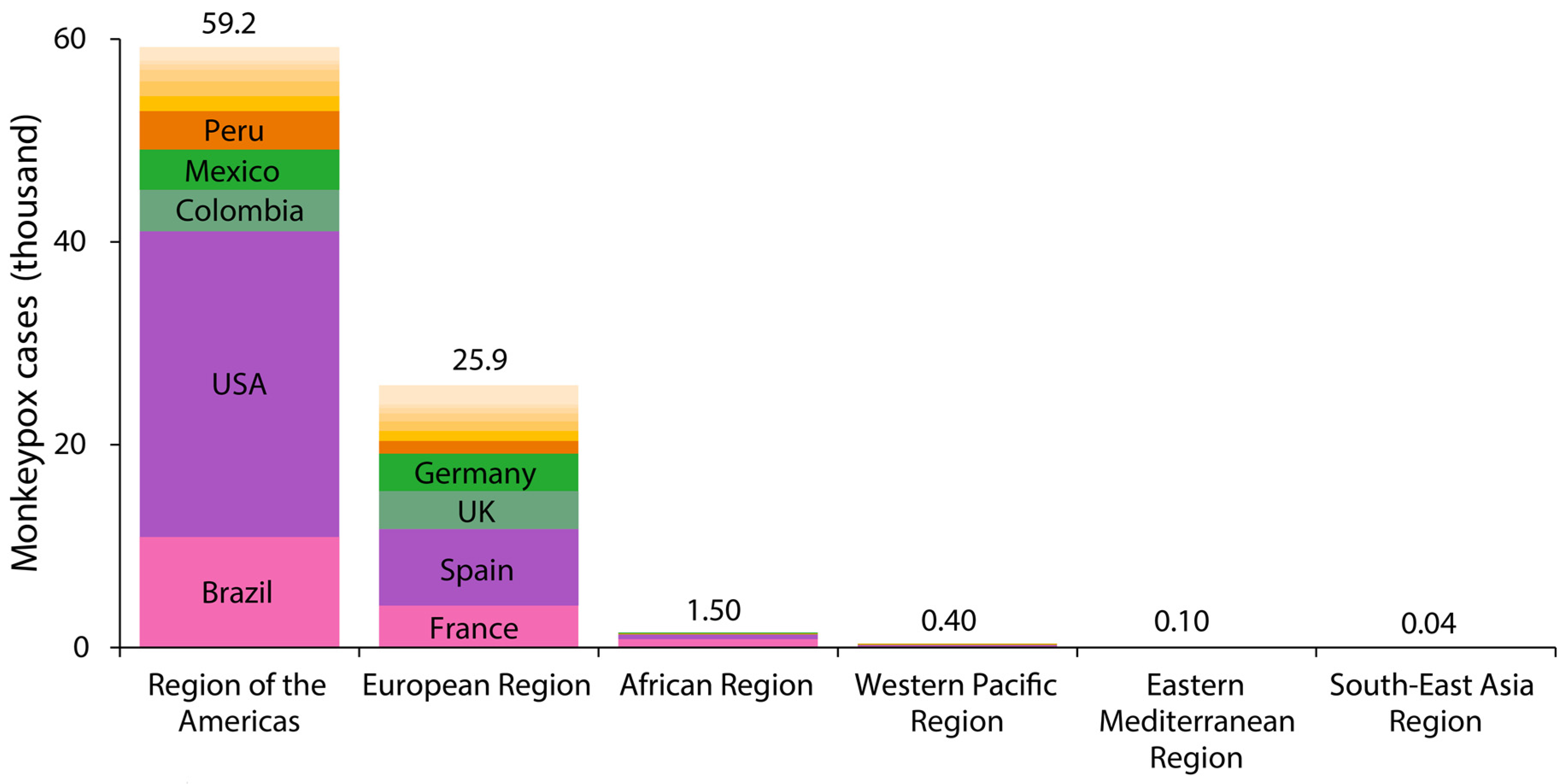

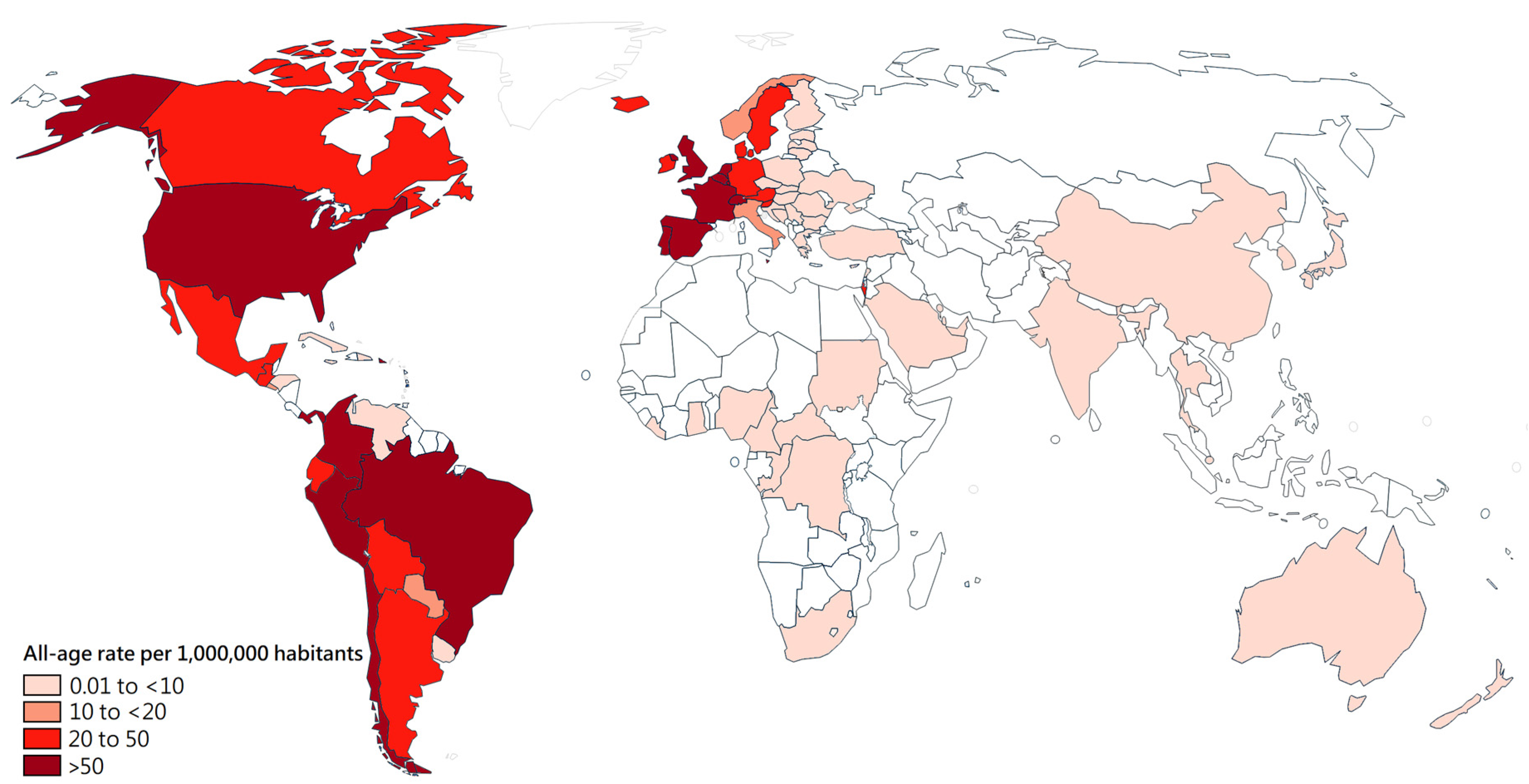
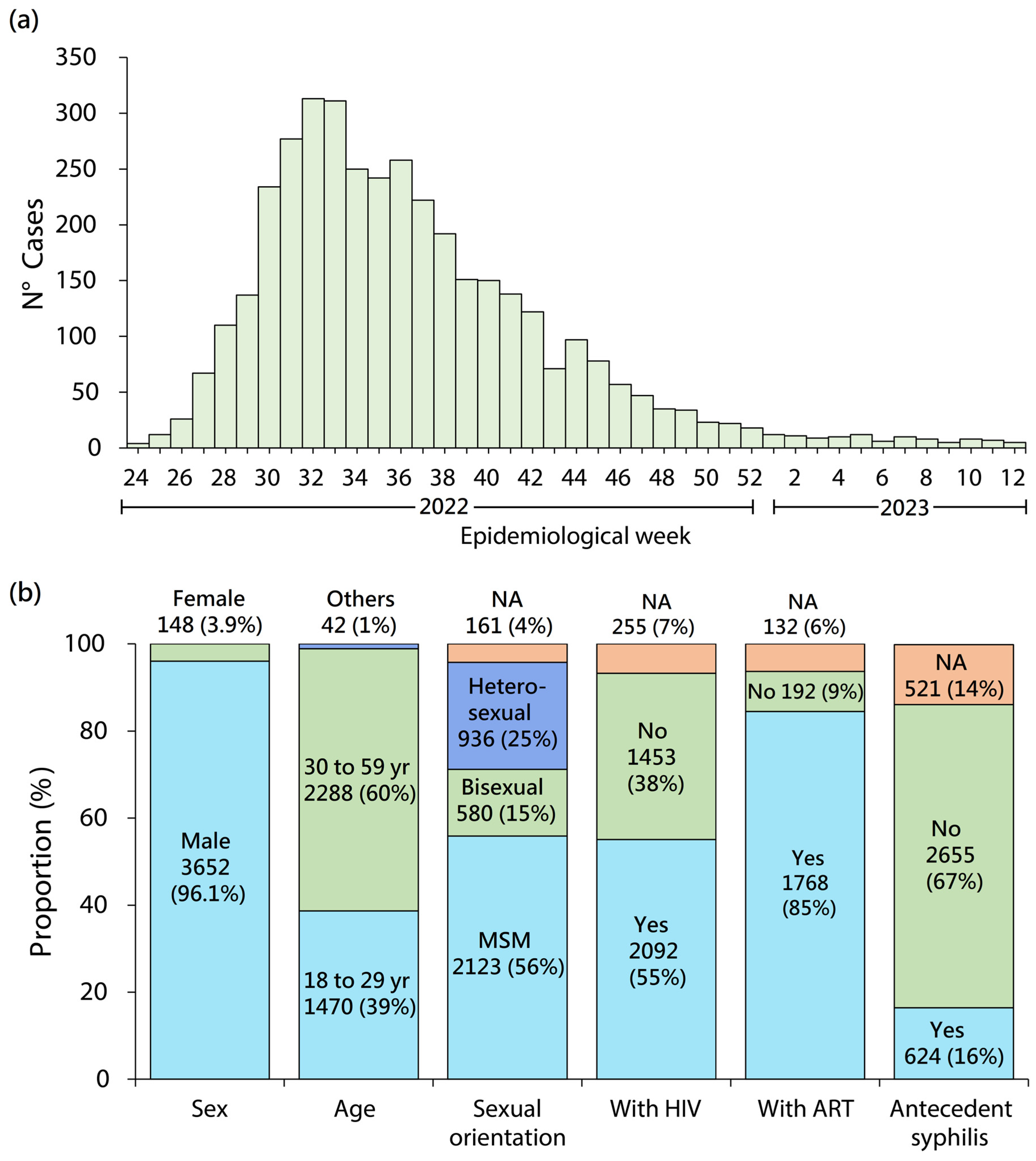
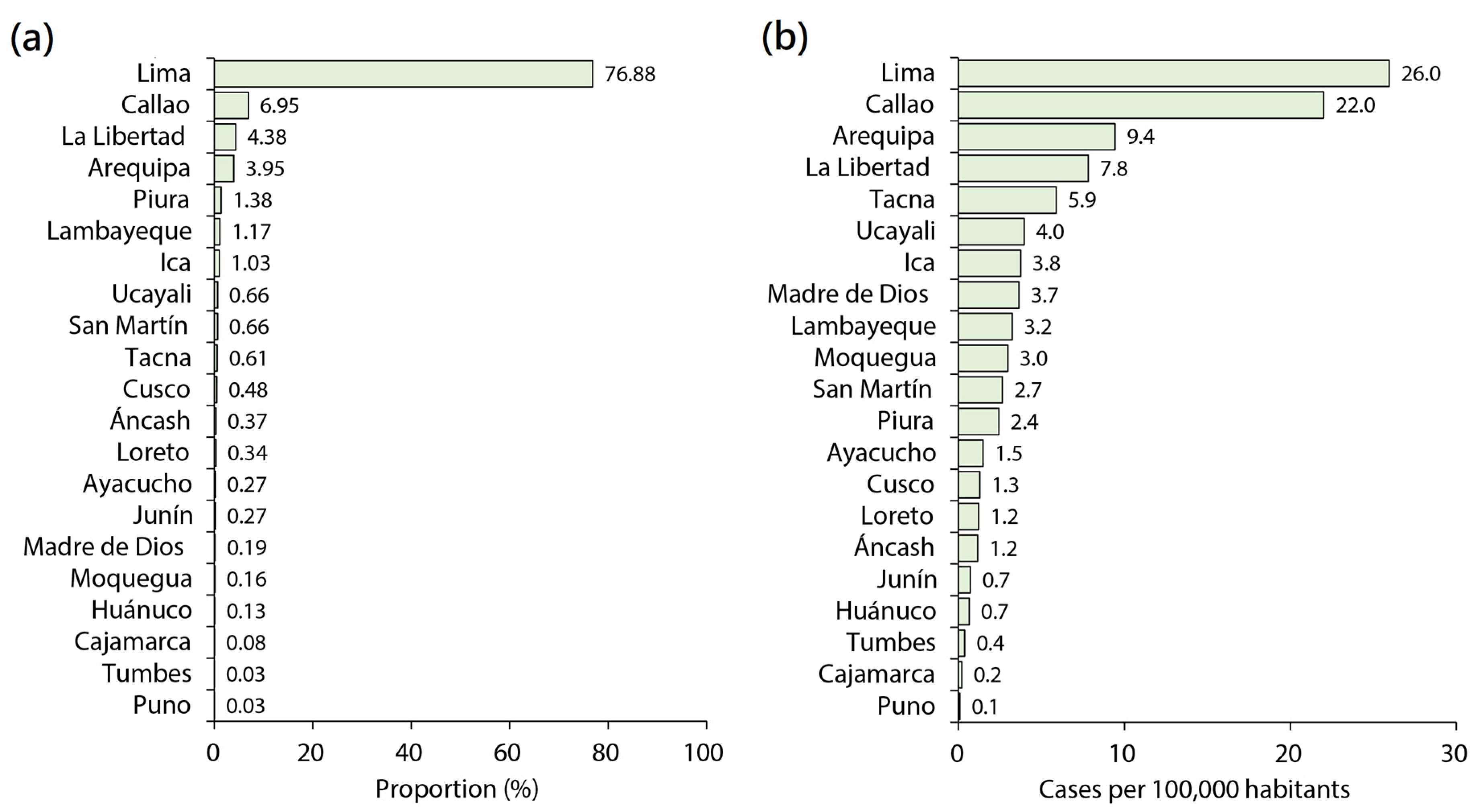
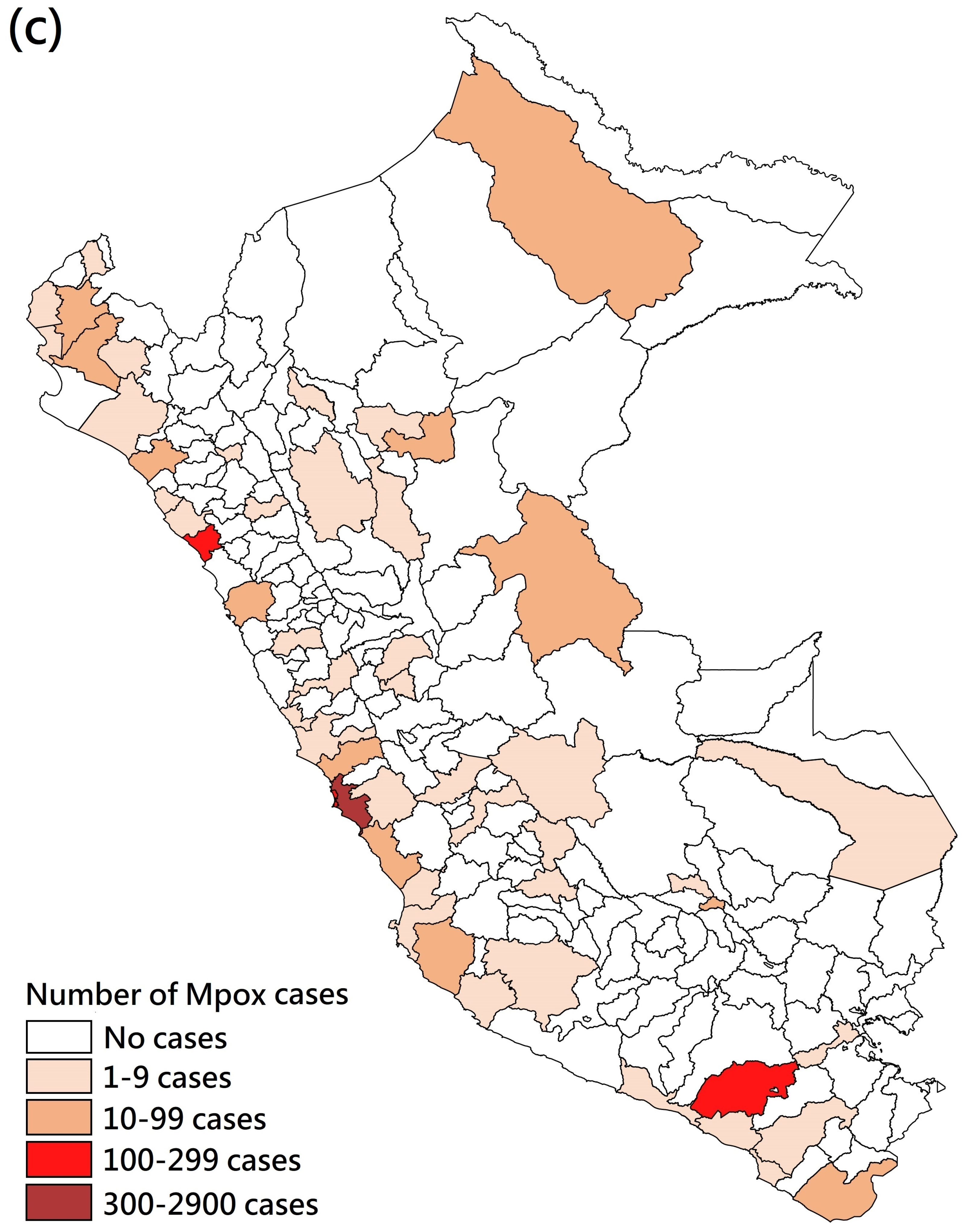
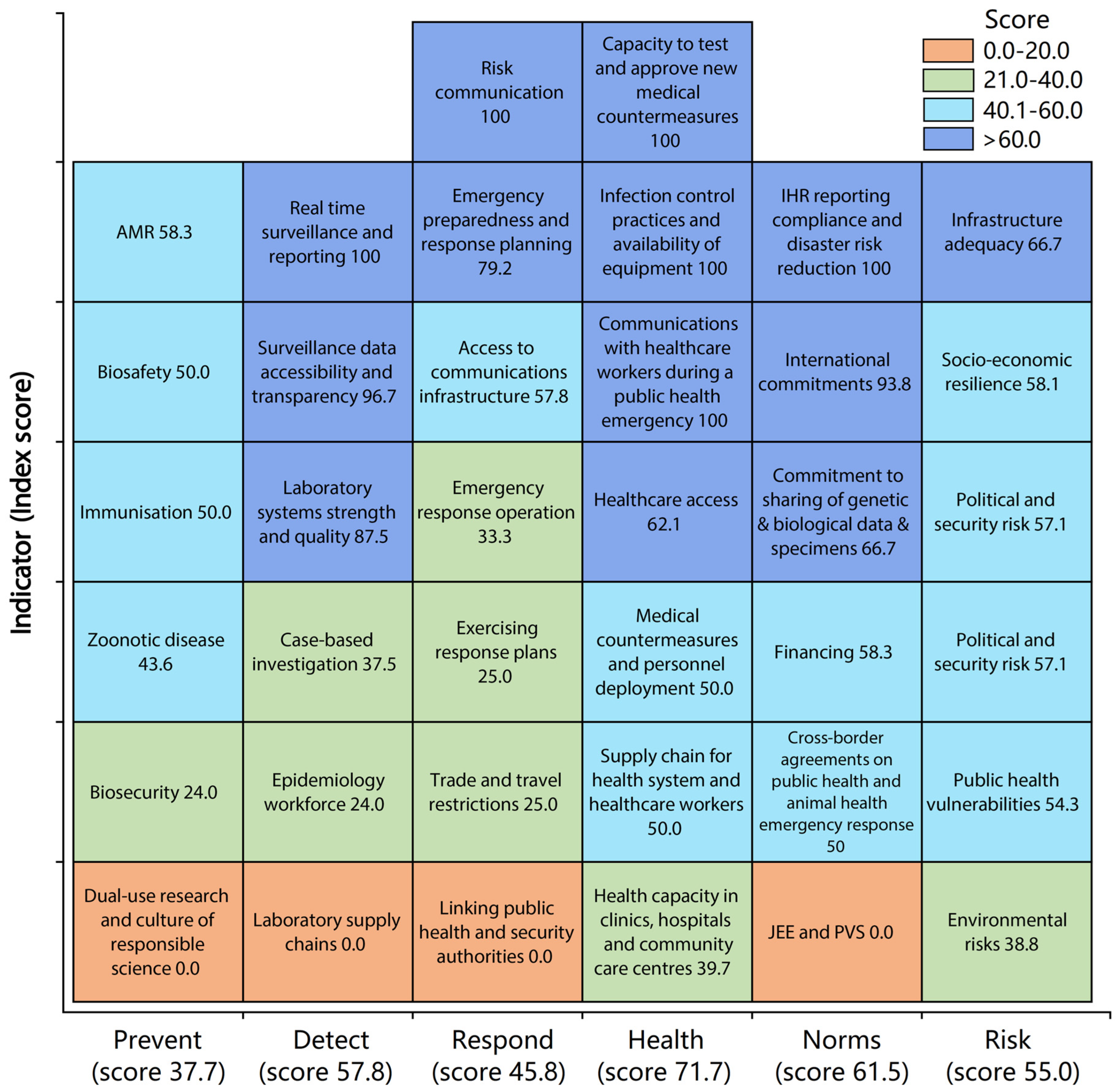

Disclaimer/Publisher’s Note: The statements, opinions and data contained in all publications are solely those of the individual author(s) and contributor(s) and not of MDPI and/or the editor(s). MDPI and/or the editor(s) disclaim responsibility for any injury to people or property resulting from any ideas, methods, instructions or products referred to in the content. |
© 2023 by the author. Licensee MDPI, Basel, Switzerland. This article is an open access article distributed under the terms and conditions of the Creative Commons Attribution (CC BY) license (https://creativecommons.org/licenses/by/4.0/).
Share and Cite
Ramírez-Soto, M.C. Monkeypox Outbreak in Peru. Medicina 2023, 59, 1096. https://doi.org/10.3390/medicina59061096
Ramírez-Soto MC. Monkeypox Outbreak in Peru. Medicina. 2023; 59(6):1096. https://doi.org/10.3390/medicina59061096
Chicago/Turabian StyleRamírez-Soto, Max Carlos. 2023. "Monkeypox Outbreak in Peru" Medicina 59, no. 6: 1096. https://doi.org/10.3390/medicina59061096
APA StyleRamírez-Soto, M. C. (2023). Monkeypox Outbreak in Peru. Medicina, 59(6), 1096. https://doi.org/10.3390/medicina59061096








